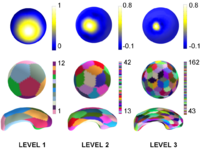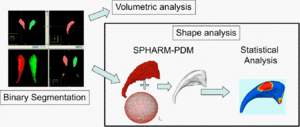Difference between revisions of "Projects:MultiscaleShapeAnalysis"
| Line 1: | Line 1: | ||
| + | Multiscale Shape Analysis applied to Caudate and Hippocampus | ||
| + | |||
Back to [[NA-MIC_Collaborations|NA-MIC_Collaborations]] | Back to [[NA-MIC_Collaborations|NA-MIC_Collaborations]] | ||
| − | + | '''Objective''' | |
We present a novel method of statistical surface-based morphometry based on the use of non-parametric permutation tests and a spherical wavelet (SWC) shape representation. As an application, we analyze two brain structures, the caudate nucleus and the hippocampus. We show that the results nicely complement the results obtained with shape analysis using a sampled point representation (SPHARM-PDM). | We present a novel method of statistical surface-based morphometry based on the use of non-parametric permutation tests and a spherical wavelet (SWC) shape representation. As an application, we analyze two brain structures, the caudate nucleus and the hippocampus. We show that the results nicely complement the results obtained with shape analysis using a sampled point representation (SPHARM-PDM). | ||
| − | + | ''Overview'' | |
| − | + | Pre-processing | |
[[Image:UNCShape_OverviewAnalysis_MICCAI06.gif|thumb|right|300px|]] | [[Image:UNCShape_OverviewAnalysis_MICCAI06.gif|thumb|right|300px|]] | ||
| Line 19: | Line 21: | ||
# Retriangulation: samples the parameterized and aligned surface meshes into triangulated surfaces (SPHARM-PDM) via icosahedron subdivision of the spherical parametrization. These SPHARM-PDM surfaces are all spatially aligned using rigid Procrustes alignment. | # Retriangulation: samples the parameterized and aligned surface meshes into triangulated surfaces (SPHARM-PDM) via icosahedron subdivision of the spherical parametrization. These SPHARM-PDM surfaces are all spatially aligned using rigid Procrustes alignment. | ||
| − | + | Spherical Wavelet Features | |
[[Image:Basis_membership.png|thumb|right|200px|Figure 2: Visualization of spherical wavelet basis functions and associated regions at three levels (columns). Top row : Values of single spherical Wavelet Basis Function shown on the sphere at scales 1 through 3. Middle and Bottom row: Regions of influence of the spherical wavelet basis functions shown on the sphere and on the original surface, each basis function region has a random color.]] | [[Image:Basis_membership.png|thumb|right|200px|Figure 2: Visualization of spherical wavelet basis functions and associated regions at three levels (columns). Top row : Values of single spherical Wavelet Basis Function shown on the sphere at scales 1 through 3. Middle and Bottom row: Regions of influence of the spherical wavelet basis functions shown on the sphere and on the original surface, each basis function region has a random color.]] | ||
| Line 25: | Line 27: | ||
For each triangulated SPHARM-PDM surface (and its corresponding spherical parameterization), a spherical wavelet description is computed. As a result, each shape is represented by a series of 3D spherical wavelet coefficients (SWC). Each 3D coefficient is associated with a basis function that describes a region of the surface. The size of that region depends on the scale of the coefficient. Therefore each 3D coefficient describes the shape at a specific scale and spatial region (See Figure 2). | For each triangulated SPHARM-PDM surface (and its corresponding spherical parameterization), a spherical wavelet description is computed. As a result, each shape is represented by a series of 3D spherical wavelet coefficients (SWC). Each 3D coefficient is associated with a basis function that describes a region of the surface. The size of that region depends on the scale of the coefficient. Therefore each 3D coefficient describes the shape at a specific scale and spatial region (See Figure 2). | ||
| − | + | Statistics | |
We use the UNC [[Algorithm:UNC:Shape_Analysis#Statistics|statistical test toolbox]] that analyzes differences between two groups of surfaces described by a set of features. The group differences are computed locally for every feature using the standard robust Hotelling T^2 two sample metric. Statistical p-values, both raw and corrected for multiple comparisons are given as output. The toolbox outputs a global average P-value for all features, as well as a raw and corrected P-value for each feature. We use the 3D spherical wavelet coefficients as features. | We use the UNC [[Algorithm:UNC:Shape_Analysis#Statistics|statistical test toolbox]] that analyzes differences between two groups of surfaces described by a set of features. The group differences are computed locally for every feature using the standard robust Hotelling T^2 two sample metric. Statistical p-values, both raw and corrected for multiple comparisons are given as output. The toolbox outputs a global average P-value for all features, as well as a raw and corrected P-value for each feature. We use the 3D spherical wavelet coefficients as features. | ||
| − | + | Significance Maps | |
If a feature (3D spherical wavelet coefficient) is found significant (i.e. its P-value is less than a pre-determined significance level, such as 0.05), we color all points that are in the support of that basis function at that scale with the corresponding P-value. This allows us to visualize both the raw and FDR corrected P-values as significance color maps on the surface of the mean shape of the structure under study. The color at each point is the P-value. | If a feature (3D spherical wavelet coefficient) is found significant (i.e. its P-value is less than a pre-determined significance level, such as 0.05), we color all points that are in the support of that basis function at that scale with the corresponding P-value. This allows us to visualize both the raw and FDR corrected P-values as significance color maps on the surface of the mean shape of the structure under study. The color at each point is the P-value. | ||
| − | + | '''Progress''' | |
We conducted statistical shape analysis of two brain structures, the caudate nucleus and hippocampus, using spherical wavelet coefficients (SWC) as features and compare the results obtained to shape analysis using a SPHARM-PDM representation. | We conducted statistical shape analysis of two brain structures, the caudate nucleus and hippocampus, using spherical wavelet coefficients (SWC) as features and compare the results obtained to shape analysis using a SPHARM-PDM representation. | ||
| − | + | ''References'' | |
* D. Nain, M. Styner, M. Niethammer, J. J. Levitt, M E Shenton, G Gerig, A. Bobick, A. Tannenbaum. Statistical Shape Analysis of Brain Structures using Spherical Wavelets. Submitted to ISBI 2007. | * D. Nain, M. Styner, M. Niethammer, J. J. Levitt, M E Shenton, G Gerig, A. Bobick, A. Tannenbaum. Statistical Shape Analysis of Brain Structures using Spherical Wavelets. Submitted to ISBI 2007. | ||
| Line 45: | Line 47: | ||
* Y. Gao, D. Nain, M. Styner, M. Niethammer, J. J. Levitt, M E Shenton, G Gerig, A. Bobick, A. Tannenbaum. Framework for the Statistical Shape Analysis of Brain Structures using Spherical Wavelets. In preparation for the Insight Journal, February/March 2007. | * Y. Gao, D. Nain, M. Styner, M. Niethammer, J. J. Levitt, M E Shenton, G Gerig, A. Bobick, A. Tannenbaum. Framework for the Statistical Shape Analysis of Brain Structures using Spherical Wavelets. In preparation for the Insight Journal, February/March 2007. | ||
| − | + | '''Key Investigators''' | |
* Core 1: | * Core 1: | ||
| Line 53: | Line 55: | ||
** Harvard PNL: James Levitt, Marc Niethammer, Sylvain Bouix, Martha Shenton | ** Harvard PNL: James Levitt, Marc Niethammer, Sylvain Bouix, Martha Shenton | ||
| − | + | '''Links''' | |
* [[Algorithm:UNC:Shape_Analysis|UNC Shape Analysis]] | * [[Algorithm:UNC:Shape_Analysis|UNC Shape Analysis]] | ||
* [[Algorithm:GATech|Georgia Tech Summary Page]] | * [[Algorithm:GATech|Georgia Tech Summary Page]] | ||
* [[NA-MIC_Collaborations|NA-MIC_Collaborations]] | * [[NA-MIC_Collaborations|NA-MIC_Collaborations]] | ||
Revision as of 00:53, 4 September 2007
Home < Projects:MultiscaleShapeAnalysisMultiscale Shape Analysis applied to Caudate and Hippocampus
Back to NA-MIC_Collaborations
Objective
We present a novel method of statistical surface-based morphometry based on the use of non-parametric permutation tests and a spherical wavelet (SWC) shape representation. As an application, we analyze two brain structures, the caudate nucleus and the hippocampus. We show that the results nicely complement the results obtained with shape analysis using a sampled point representation (SPHARM-PDM).
Overview
Pre-processing
We use the UNC Pipeline to pre-process the shapes. The input is a set of binary segmentation of a single brain structure. We use the following steps from the pipeline:
- Morphological operations: fills any interior holes and applies a minimal smoothing operation
- Surface conversion: converts the processed binary segmentations to surface meshes
- Spherical Parameterization: computes a spherical parameterization for the surface meshes using a area-preserving, distortion minimizing spherical mapping
- Alignment: computes a spherical harmonic (SPARM) description of the parameterized surface meshes and aligns the spherical parameterizations using the first order ellipsoid from the spherical harmonic coefficients.
- Retriangulation: samples the parameterized and aligned surface meshes into triangulated surfaces (SPHARM-PDM) via icosahedron subdivision of the spherical parametrization. These SPHARM-PDM surfaces are all spatially aligned using rigid Procrustes alignment.
Spherical Wavelet Features

For each triangulated SPHARM-PDM surface (and its corresponding spherical parameterization), a spherical wavelet description is computed. As a result, each shape is represented by a series of 3D spherical wavelet coefficients (SWC). Each 3D coefficient is associated with a basis function that describes a region of the surface. The size of that region depends on the scale of the coefficient. Therefore each 3D coefficient describes the shape at a specific scale and spatial region (See Figure 2).
Statistics
We use the UNC statistical test toolbox that analyzes differences between two groups of surfaces described by a set of features. The group differences are computed locally for every feature using the standard robust Hotelling T^2 two sample metric. Statistical p-values, both raw and corrected for multiple comparisons are given as output. The toolbox outputs a global average P-value for all features, as well as a raw and corrected P-value for each feature. We use the 3D spherical wavelet coefficients as features.
Significance Maps
If a feature (3D spherical wavelet coefficient) is found significant (i.e. its P-value is less than a pre-determined significance level, such as 0.05), we color all points that are in the support of that basis function at that scale with the corresponding P-value. This allows us to visualize both the raw and FDR corrected P-values as significance color maps on the surface of the mean shape of the structure under study. The color at each point is the P-value.
Progress
We conducted statistical shape analysis of two brain structures, the caudate nucleus and hippocampus, using spherical wavelet coefficients (SWC) as features and compare the results obtained to shape analysis using a SPHARM-PDM representation.
References
- D. Nain, M. Styner, M. Niethammer, J. J. Levitt, M E Shenton, G Gerig, A. Bobick, A. Tannenbaum. Statistical Shape Analysis of Brain Structures using Spherical Wavelets. Submitted to ISBI 2007.
- M. Styner, I. Oguz, S. Xu, C. Brechbuehler, D. Pantazis, J. Levitt, M. Shenton, G. Gerig. Framework for the Statistical Shape Analysis of Brain Structures using SPHARM-PDM. MICCAI 2006 Open Source Workshop. Insight Journal DSpace link: http://hdl.handle.net/1926/215
- Y. Gao, D. Nain, X. LeFaucheur, A. Tannenbaum. A Spherical Wavelet ITK Filter. In preparation for the Insight Journal, December 2006.
- Y. Gao, D. Nain, M. Styner, M. Niethammer, J. J. Levitt, M E Shenton, G Gerig, A. Bobick, A. Tannenbaum. Framework for the Statistical Shape Analysis of Brain Structures using Spherical Wavelets. In preparation for the Insight Journal, February/March 2007.
Key Investigators
- Core 1:
- Georgia Tech: Delphine Nain, Yi Gao, Xavier Le Faucheur, Allen Tannenbaum
- UNC: Martin Styner
- Core 3:
- Harvard PNL: James Levitt, Marc Niethammer, Sylvain Bouix, Martha Shenton
Links
